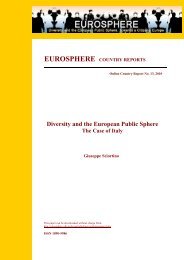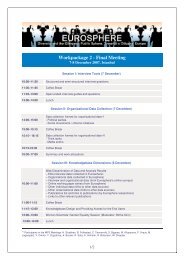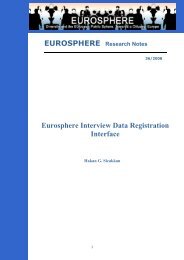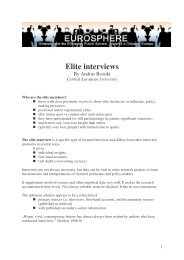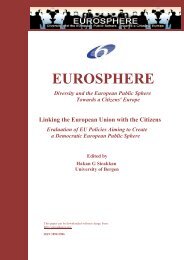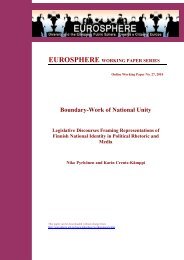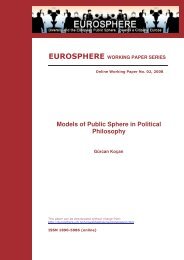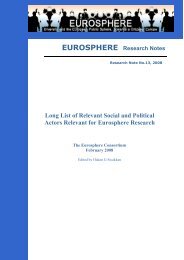Migrants, Minorities, Belongings and Citizenship. Glocalization and ...
Migrants, Minorities, Belongings and Citizenship. Glocalization and ...
Migrants, Minorities, Belongings and Citizenship. Glocalization and ...
Create successful ePaper yourself
Turn your PDF publications into a flip-book with our unique Google optimized e-Paper software.
all boundaries, including also the European boundaries, through the window of their<br />
ethnically – <strong>and</strong> to a lesser extent also religiously – oriented diasporic belongings. Those<br />
who score low here are the glocalists, who look beyond all conventional boundaries <strong>and</strong><br />
turn to non-essentialized, new, boundary-breaking <strong>and</strong> extended modes of belonging –<br />
such as the global, transnational, <strong>and</strong> European belongings. The high-scorers regard their<br />
diasporic belongings as more relevant in this context. The low-scorers, on the other<br />
h<strong>and</strong>, consider their borderless belongings as more relevant; <strong>and</strong>, in this context,<br />
“European belonging”, “global belonging”, “individual belongings”, <strong>and</strong> “political<br />
belonging” are all more acceptable for them than “transnational belongings”. For the<br />
former four belongings break with essentialized national or diasporic belongings whereas<br />
“transnational belonging” builds on diasporas, ethnic groups, religions or national<br />
territories. In this sense, this dimension is not exclusively about “European belonging”<br />
but about how the boundaries should relate to individuals’ belongings – transnationalism<br />
or globalism. Those respondents who have moderate scores on this dimension can be<br />
interpreted as relating finely to the existing belonging boundaries.<br />
In type-3 multidimensional belonging model (dimension 3), European belonging relates<br />
positively to almost all belongings except territorial, gender, <strong>and</strong> sexual belongings.<br />
Similar to the second dimension, also this dimension is not exclusively about “European<br />
belonging”. “European belonging” clusters with the other “non-collective” belonging<br />
modes – i.e. global, transnational, etc – because it is seen by the respondents who score<br />
high as more cosmopolitan than “collective” <strong>and</strong> territory-based belongings.<br />
In type-4 multidimensional belonging model, the European belonging loads barely on<br />
dimension 4, however it relates positively to religious <strong>and</strong> national belongings. Therefore,<br />
this multidimensional mode of belonging is primarily about the degree of respondents’<br />
political belonging. Here, “political belonging” clusters with ethnic, gender, <strong>and</strong> sexual<br />
belongings, which are themes of political relevance in the Western world. In this sense,<br />
this dimension has nothing to do with “European belonging”.<br />
“European belonging” loads strongest on dimension 5. In type-5 multidimensional<br />
belonging pattern, European belonging relates positively to national, territorial <strong>and</strong><br />
religious belongings. Amongst the five dimensions that we uncovered in this CATPCAanalysis,<br />
this is the only dimension where there is a clear alignment between<br />
respondents’ territorial belongings <strong>and</strong> their senses of “being European”. Therefore, we<br />
looked into our fieldwork reports <strong>and</strong> notes in order to see how the high scorers on this<br />
dimension relate their territorial belonging to Europe. The connection they make is that<br />
they regard the territory of their own country as Europe. Therefore, this territorial-<br />
European identity refers to the “territory of Europe” rather than member states’<br />
72



